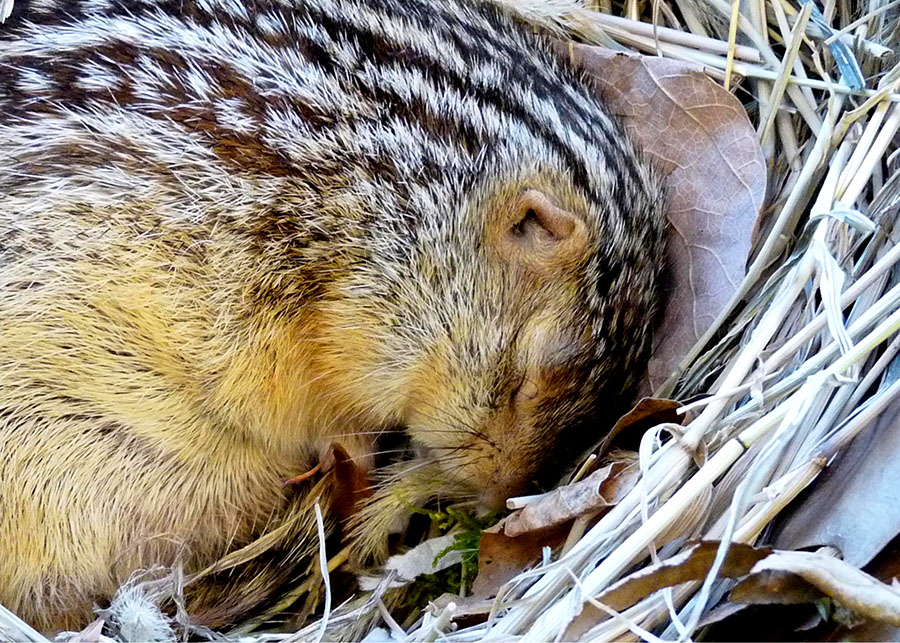A hibernating ground squirrel wouldn’t look like much, even if you could spot it. But curled into furry balls from October to April, these pint-sized mammals have genetic adaptations that could be applied to next-generation therapeutics for humans.
When ground squirrels hibernate, which they do for about six months each year, their heart rates drop, and their only brain activity is that required for essential function—essentially, they’re brain dead. But squirrels can survive periods of low oxygenation, or hypoxia, during massive, biweekly shifts in their body temperature. Those same conditions in a person would cause heart attacks, strokes, and even death. Yet, ground squirrels recover from these damaging episodes dozens of times each winter during hibernation.
Their heart rates drop to five beats per minute while body temperatures dip to about 39°F. Every other week or so, their bodies rapidly rewarm, increasing their metabolism by 235 times in a single hour, flooding their organs with warm, oxygenated blood.
It’s similar to what might happen when doctors insert a stent after a heart attack. In humans, when oxygenated blood re-enters damaged heart muscle, it can cause reperfusion injuries. But ground squirrels withstand similar stressors numerous times every hibernation season, year after year, without suffering lasting injury.
“The fact that they do get some damage actually makes them more interesting models,” says veterinarian Ashley Zehnder, CEO of the Emeryville, California, biotech company Fauna Bio. “If they were just protected entirely from stress, it would be harder to understand how they reverse that damage later on.”
Zehnder is one of a trio of scientists who launched Fauna Bio as a startup in 2018 with the goal of matching genetic advantages that evolved in mammals to new therapies that can prevent, reverse, and treat disease in humans. That means mining the genomes of deer mice, ground squirrels, and other mammals with an eye to mimicking these evolutionary advantages in humans.
“It’s a really innovative way of using evolutionary methods that have been around for a very long time to identify targets for novel drug discovery,” says Abbe Leavitt LaBella, an evolutionary geneticist at the University of North Carolina, Charlotte. And it may be a timely innovation as well, as medical schools are just starting to include evolutionary medicine in curricula and gene sequencing tools become cheaper and faster.
Celestine Schnugg, founder of Boom Capital Ventures, is accustomed to long odds. Of the early-stage investments she manages, only about 1 percent will likely succeed long-term. “Something I look for as an investor is, were people like this put on the Earth to solve a single problem, and have they been training pretty much their entire life to solve that problem?” she says.

According to Schnugg, Fauna Bio’s founders are a bullseye: Zehnder’s veterinary expertise (and a touch of genius—she entered veterinary school at 20) pairs with the computational biology know-how of co-founder Linda Goodman and unique ground squirrel expertise (plus her own expansive datasets) from the founding trio’s third member, geneticist Katie Grabek. Together, Fauna Bio’s founders aim to upend traditional drug development.
A new blueprint for pharmaceutical R&D
Today, researchers test the first possible therapies for disease in the lab, then on animals, before moving on to human trials. It works somewhat for pre-clinical trials, but isn’t a fruitful path for drug discovery, Zehnder says, because of how difficult it is to modify a mouse to mimic a human. In practice, successful therapies tested on mice—even genetically altered mice—rarely make it through clinical trials in humans.
Instead of starting with a disease and looking for ways to treat or prevent it, Zehnder, Goodman, and Grabek are identifying genetic adaptations, then mapping them to human ailments.
When they look at these types of physiologies molecularly and at a tissue level, Zehnder says, they often see changes in the key underlying pathways. And those pathways typically have parallels for more than one type of human disease.
Mining animal genomes is a newer angle for drug development—and few have looked closely at species like ground squirrels—but it’s hardly an easy fix.
“If I was to look at the list of the top 25 pharmaceutical companies in the world today, and what that list is going to be 10 years from now, I think two-thirds of that list would be new names,” says Rohit Sharma of True Ventures, Fauna Bio’s first investor and a current member of its board. The startup’s biggest challenge isn’t whether its drugs will survive clinical trials, Sharma says. It’s how to choose the right targets from a myriad of options.
“While you can re-sequence a human for less than $1,000 today, sequencing a new species costs about ten thousand dollars and takes a few weeks.”
“You could sort of start anywhere, and that was a little bit daunting when we started the company,” Zehnder says. In the past, the high costs of genome sequencing made it difficult to identify these genetic feats. It was simply too costly to establish an accepted reference genome for each species, against which individuals might be compared. But in recent years, this has changed.
Twenty years ago, scientists finished sequencing the first human genome. It cost about a billion dollars and took a decade. By the next year, 2004, we had sequenced four more mammalian genomes. Today, we have sequences for 452 mammals, according to Fauna Bio’s CTO and sequencing expert, Linda Goodman. More than 200 of those were done in the past five years alone, including the North American beaver, Northern rock mouse, and Allen’s swamp monkey.
“While you can re-sequence a human for less than $1,000 today, sequencing a new species costs about $10,000 and takes a few weeks,” Goodman says.
In the past decade, advances in genome sequencing technology made it cheaper and faster to sequence new species, broadening available datasets. Advances in machine learning and computational biology mean scientists can compare swathes of these repositories at a time, making it easier than ever to pinpoint the best targets for drug discovery.
“The more genomes, the more tissue samples, the more information they can put into their models, the more possible targets they’ll get out,” Leavitt LaBella says.
One such repository is the NIH’s LINCS L1000 dataset. This assay catalogs human genome reactions to 34,000 compounds. Comparing this dataset to, say, a pattern of genetic activity that’s protective to squirrels helps predict potential winners among a host of drug candidates that might upregulate the same protective gene expression in humans. Fauna Bio also maintains its own biobank of 22 tissue types and partners with universities to unearth new datasets for an ever-growing list of species.
The same cluster of genes and gene regulators can cause vastly different outcomes in one species versus another, so identifying protective genetic adaptation in mammals that could be helpful to humans is only the first step.

Fauna’s hoped-for pharmaceuticals
Fauna Bio doesn’t have any drugs in clinical trials just yet, though Sharma anticipates they could bring a drug to market in the next few years.
“Once we identify the genes that we want to replicate, the core signature of the protection that we want to replicate, we can map that directly to compounds,” Zehnder says.
“These animals don’t get close to a pathological state and then reverse it. They avoid getting into the state in the first place.”
The first compound Fauna Bio has identified is named discreetly: compound 1003. It antagonizes a gene linked to lung inflammation or edema, an early hallmark of pulmonary fibrosis. What they’re finding is that mice treated with the compound in the lab can recover some of their lung function (like it or not, Zehnder is still locked into the traditional model of pharmaceutical testing). The compound is now being tweaked to best target pulmonary fibrosis in people. Once they have a compound ready for human testing, they will seek to do the standard clinical trials for safety and efficacy over the coming years. Its success, if and when it comes, would help fuel Fauna Bio’s trajectory.
Matthew Pamenter, a comparative physiologist at the University of Ottawa in Canada, is an expert in how animals adapt to low-oxygen environments. Fauna Bio’s approach to drug development, he says, is proactive. “These animals don’t get close to a pathological state and then reverse it. They avoid getting into the state in the first place,” he says. Preventing disease is easier than treating it.
So far, Big Pharma has reached out—Fauna Bio is partnering with Novo Nordisk—along with a handful of universities that have research programs in the genetics of various mammals. Zehnder says she hasn’t been approached with any buyout offers so far. But investors will surely be watching to see whether basing R&D on existing adaptations in other species offers promise, and profit, for a new wave of drug development.
For now, the squirrels sit in their hidey-holes for the winter. Curled up. Waiting.
















